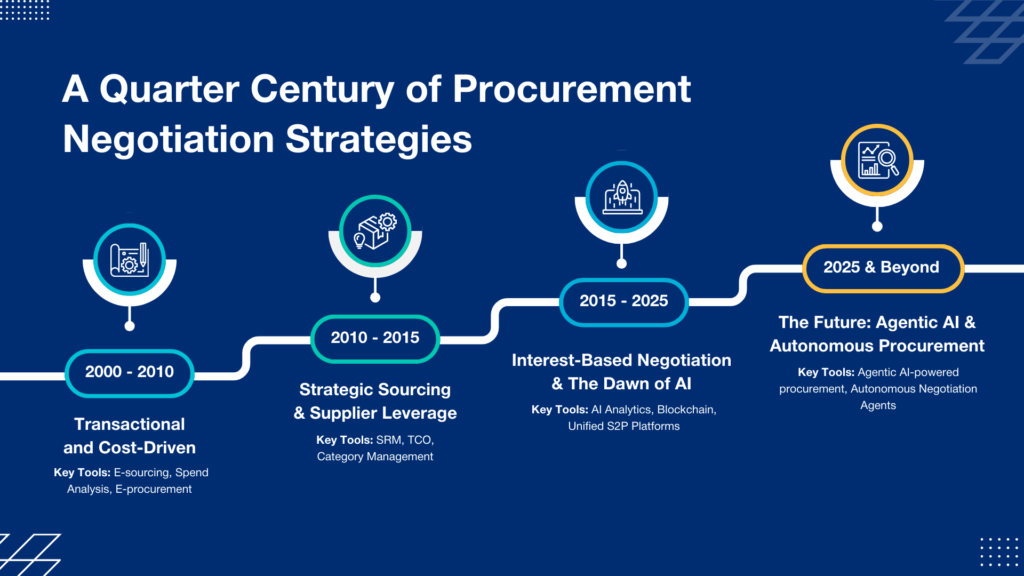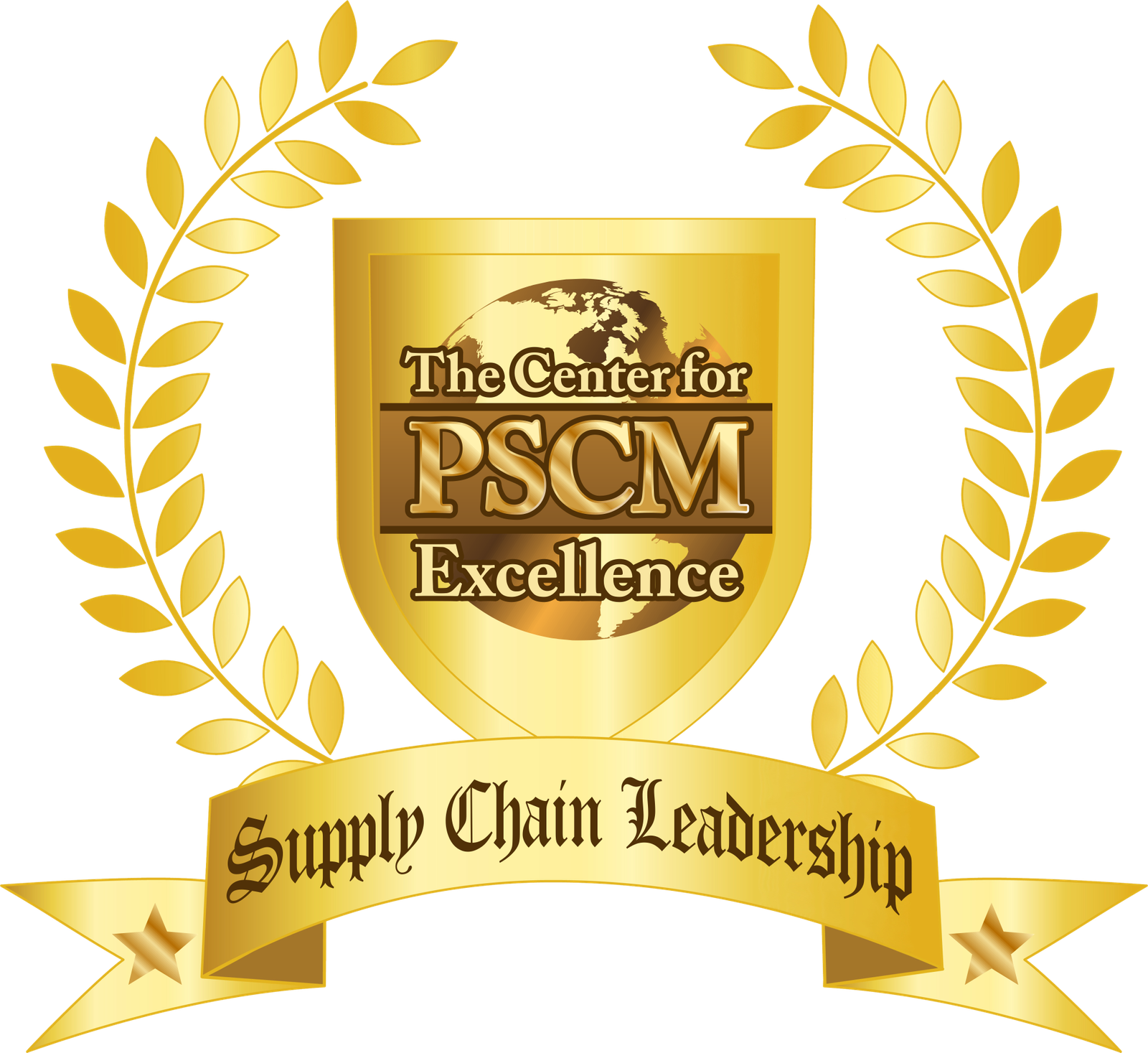
Having spent more than three decades in the procurement profession, working with countless Fortune 500 firms, I’ve witnessed a significant evolution in procurement negotiation strategies. This retrospective highlights key shifts over the past 25 years, focusing on the transition from purely transactional approaches to highly sophisticated, AI-driven, and autonomous procurement methods.
Early Years: Transactional and Cost-Driven (2000–2010)
In the early 2000s, procurement was largely cost-focused, with most organizations developing more sophisticated commodity teams to manage negotiations. Gone was the generalist negotiator, as procurement sought to negotiate with suppliers toe to toe, leveraging commodity expertise. Organizations prioritized centralization, bulk purchasing, competitive bidding, and game changing procurement systems and tools to achieve savings. Cost efficiency was the primary driver, and procurement teams relied on multi-supplier bidding, many times using online reverse auctions, to reduce costs. During this period, tail spends —low-value, high-volume purchases—were mostly unmanaged, leading to inefficiencies that still plague many procurement organizations today.
Total cost analysis became a major theme and source of common understanding, but organizations struggled to implement correctly, and bottom-line oriented finance organizations frequently failed to value the same as pure cost reductions. Negotiation strategies centered on positional bargaining, with volume discounts and long-term fixed pricing as key tactics. Negotiation training focused on cost analysis and at-the-table tactics and counter-tactics. Procurement negotiators grew their scope internally, though certain longtime independently operating business units – such as marketing and HR – frequently fell outside of procurement jurisdiction. Though win-win negotiations were a regular basis for dialogue with suppliers, aggressive cost-cutting measures often left suppliers feeling like they were not put into practice.
Key Tools Developed:
- E-sourcing platforms to facilitate online auctions and competitive bidding.
- Spend analysis tools to identify cost-saving opportunities.
- E-procurement systems to streamline purchasing processes.
Strategic Sourcing & Supplier Leverage (2010–2015)
By 2010, procurement evolved beyond commodity driven cost savings strategies to more advanced strategic sourcing, with the goal of long-term value creation with strategic supplier partnerships. This entailed greater Total Cost of Ownership (TCO) focus, supplier relationship management (SRM) strategies, market analysis & risk management, multi-category optimization, increased focus on sustainability & compliance measures and overall contract governance. However, despite progress on the largest expenditure areas through these measures, tail spends remained largely uncontrolled throughout this period, allowing for maverick spending and compliance risks – areas left largely unnegotiated.
During this period, negotiation strategies became more sophisticated, incorporating TCO and should cost analysis, sustainability measures, supply line management strategies, and development of new sources for competition and risk reduction. Away-from-the-table negotiation strategies became more prevalent, augmenting at-the-table strategies, with frequent measures to assess and shift bargaining power in the buyer’s favor. Aggressive strategies to achieve cost targets remained in place and the pressure for procurement to achieve more costs savings each year from the same suppliers carried on.
Key Tools Developed:
- Supplier Relationship Management (SRM) Platforms that enabled systematic supplier performance tracking, risk assessments, and collaboration.
- Total Cost of Ownership (TCO) & Should-Cost Modeling Tools that helped procurement professionals evaluate lifecycle costs beyond purchase price, including maintenance, logistics, and operational costs.
- Category Management & Multi-Category Optimization Software that allowed for holistic spend analysis across multiple categories to optimize sourcing strategies.
- Market Intelligence & Risk Management Platforms that provided real-time insights on supplier markets, geopolitical risks, and industry trends to strengthen negotiation leverage.
- Contract Lifecycle Management (CLM) Systems that enhanced compliance, governance, and automation of contract approvals.
- Early AI-Driven Spend Analytics Tools that helped identify spend leakage, maverick spending, and compliance risks in tail spend management.
Interest-Based Negotiation, Advanced Analytics, & The Dawn of AI (2015–2025)
By 2015, procurement negotiations shifted toward value-based and interest-based approaches. Those organizations that employed purely cost-driven negotiations found they led to supply chain risks, poor service levels, and weakened supplier relationships. As a result, procurement teams started focusing on collaborative supplier engagement, integrating supplier risk assessments, and balancing cost with quality and innovation. Increasingly, strategic sourcing now entailed negotiating for performance results instead of just price and supply. The pandemic introduced the importance of supply chain flexibility and resiliency, and new measures prevailed to ensure both were sourced and negotiated for moving forward.
Early in this period, predictive analytics and machine learning emerged, enabling automation of procurement tasks, supplier performance forecasting, and demand trend analysis. Rudimentary tail spends management tools emerged, offering greater visibility into indirect and tactical purchases. Electronic bidding applications also appeared, automating a tactical process. Meanwhile, blockchain began transforming supply chain management by improving transparency, efficiency, and compliance. All of these innovations drove improvement in efficiency and results of negotiations processes, though in a highly modular and piecemeal fashion – with lots of “human glue” holding them together.
The biggest change however was in the latter part of this period, with game changing AI driven capabilities that streamline the entire S2P process, from end user demand intake to negotiations, demand fulfillment, and supplier payment. The most relevant innovation for this article is that the advent of fully autonomous AI capabilities that can drive end to end negotiations – for the first time automating *decisions* instead of processes. In 2025, those companies that are adopting these technologies have created a scenario whereby AI can negotiate the vast majority of transactions, and procurement is overseeing and uniquely now able to focus their energies on the truly most high dollar and strategic deals, without the constant onslaught of distractions from mid and low level transactions.
Key Tools Developed:
- AI-driven analytics for internal intake and demand management and external supply chain management.
- Blockchain-based supply chain ledgers for improved transparency and traceability.
- Modular Tail spend automation tools to help control low-value purchases.
- Unified AI driven S2P capabilities that streamline the end to end procurement process with autonomous intelligent decision automation.
The Future: Agentic AI & Autonomous Procurement (2025 & Beyond)
It’s 2025 and the future is now. With Agentic AI and Autonomous Negotiation Agents (ANA), procurement is entering an entirely new era. These AI-powered negotiation tools simulate human negotiation behaviors – with greater capabilities in fact – and are able to seamlessly automate the decision making process with intelligence, from end user intake to bidding, simultaneous multi-party negotiations, contracting, and demand fulfillment.
Leading providers in this space are embedding these capabilities within comprehensive procurement ecosystems, ensuring seamless integration from spend analytics to contract management. As organizations look to future-proof their procurement strategies, embracing platforms that deliver true autonomous negotiation capabilities will be essential. With a long-standing reputation for AI-driven innovation, solutions from companies like Zycus are at the forefront of this transformation, equipping procurement teams with the tools to not just automate, but truly optimize and elevate their negotiation strategies in an increasingly digital landscape.
The opportunity? Done right, procurement can take 50 – 70% workload off their plate – that surplus is like getting up to 70% more headcount approved. It’s a game changer, and it promises to liberate procurement departments, enable improved cost and quality results, drive faster processing time, improve business unit trust, and allow for procurement to use their freed up time in far more leveraged and strategic capacities – delivering even greater outcomes for the truly biggest deals before them.
Procurement finally has the opportunity to get out of the back office, shed their role as a value-added cost center, and sit firmly at the C-Suite table as a source of enterprise advantage. CPOs need to be on notice and take their next steps wisely.
Key Takeaways: Actionable Steps for Today’s Procurement Leaders
Drawing from 25 years of procurement evolution, here’s how you can tackle today’s challenges with practical strategies and cutting-edge tools like Zycus:
- Redefine Procurement’s Role with AI-Driven Insights – If your team is stuck handling routine transactions instead of focusing on strategic deals, AI can help. An AI-powered Source-to-Pay platform with Negotiation Agents can automate 50-70% of mid- and low-value negotiations—from request to contract—so your team can focus on what matters.
- Take Control of Tail Spend with a Holistic Strategy – Instead of treating tail spend as an afterthought, procurement should establish governance structures, strategic supplier agreements where business consolidation is possible, and leverage AI-driven oversight to turn unmanaged spend into an opportunity for efficiency and risk reduction.
- Elevate Strategic Sourcing Capabilities – Procurement is no longer just a cost center; it has the potential to drive enterprise-wide transformation. Move to interest-based negotiations, streamline costs in the SOW/Spec before negotiating externally, use supplier performance and market data to predict risks, and secure performance-based contracts that are easy to track and deliver results. AI-powered spend analytics can also highlight savings opportunities and improve supplier negotiation outcomes.


